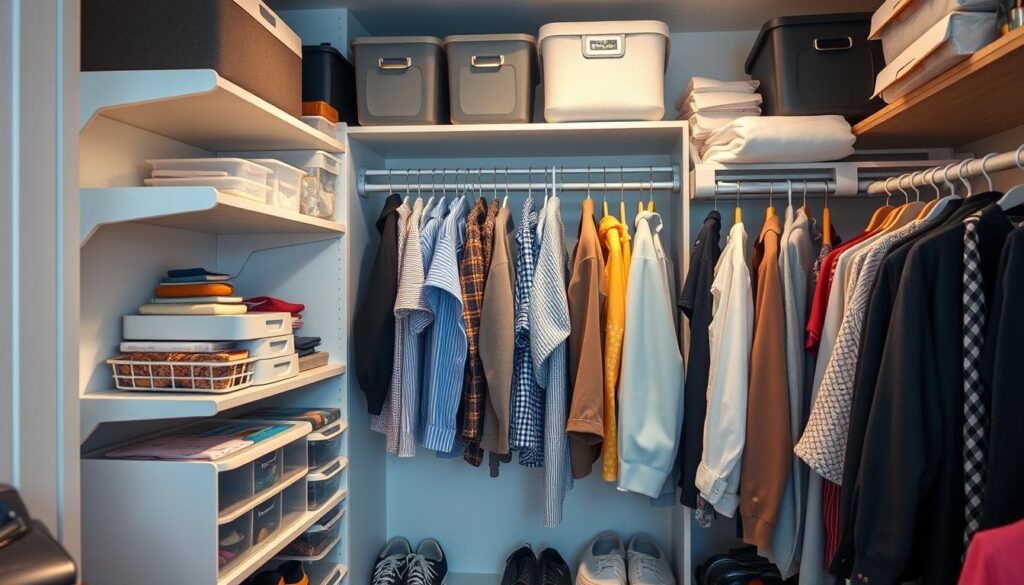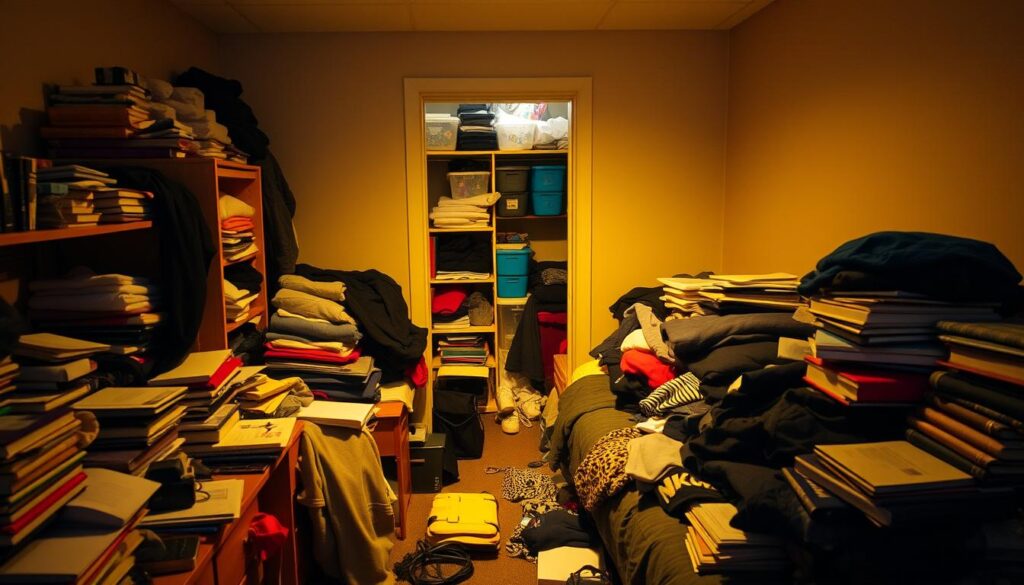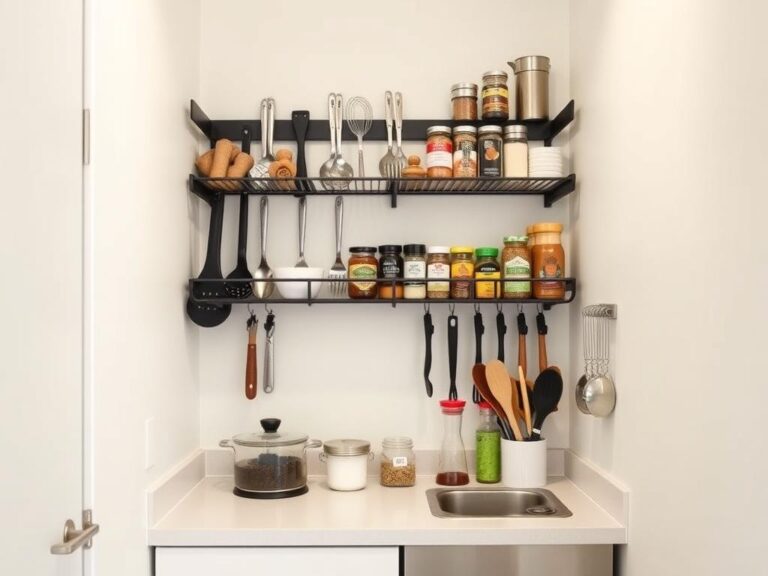Dorm closet chaos? 12 hacks to double your storage space
Maximize your dorm closet space with these 12 dorm closet hacks. Discover how to double your storage and stay organized.
Living in a compact college environment requires creative thinking. With most student housing offering less than 500 square feet, finding room for clothes, supplies, and personal items becomes a daily puzzle. Traditional storage methods often fall short in these unique living situations.

Strategic planning turns cramped areas into functional zones. Simple adjustments like rethinking vertical space or using multi-purpose containers can dramatically increase usable areas. Students frequently discover hidden potential in overlooked spots like bed risers or wall-mounted systems.
Shared accommodations add another layer of complexity. Effective systems must accommodate multiple users while maintaining accessibility. Solutions that combine personalization with shared efficiency prove most successful in these scenarios.
Key Takeaways
- Typical student housing offers less space than a studio apartment
- Vertical storage solutions increase capacity by 40-60%
- Multi-functional furniture serves dual purposes
- Collaborative systems ease roommate storage conflicts
- Immediate improvements require minimal investment
Upcoming sections detail twelve practical methods for optimizing living areas. These approaches focus on quick implementation and lasting results, helping students create orderly environments that support academic success.
Introduction: Transforming Dorm Closet Chaos
Millions of students face the annual challenge of fitting their lives into spaces smaller than most studio apartments. Shared college living areas average under 500 square feet, forcing roommates to store clothes, study materials, and personal items in the same cramped quarters. Traditional methods like bulky dressers or single-rod closets often worsen the problem, leaving no room for seasonal swaps or shared supplies.
Cluttered environments do more than create physical chaos – studies show disorganization increases stress levels by 30% and impacts academic focus. Strategic systems solve two problems at once: creating functional spaces while teaching skills that translate to post-grad life. Students who master these techniques report finding lost items 40% faster and maintaining cleaner shared areas.
What Else Would You Like to Know?
Choose below:
Effective solutions don’t require remodeling or expensive gear. Many top-rated approaches use:
- Adjustable components that adapt to changing needs
- Collapsible items for easy summer storage
- Clear containers that prevent “out of sight, out of mind” clutter
Contrary to popular belief, improving small spaces takes minutes – not days. The upcoming methods work within rental rules, using existing walls, doors, and underutilized zones. Best results come from combining multiple approaches tailored to specific room layouts and roommate habits.
Understanding the Challenges of Dorm Living
College housing often forces students to solve spatial puzzles they’ve never encountered. Standard rooms average 12×15 feet with fixed layouts, leaving little flexibility for personalization. Ceiling heights rarely exceed 8 feet, limiting vertical expansion options without violating safety codes.

Shared spaces create organizational dilemmas. Roommates might disagree on shelf divisions or seasonal item rotations, leading to cluttered surfaces. Housing policies complicate matters further – 78% of campuses prohibit adhesive hooks or drilled shelves, eliminating popular storage methods.
Seasonal wardrobe swaps strain limited areas. Winter coats occupy 3x more space than summer tees, yet both must coexist during semester transitions. Students frequently cram bulkier items into corners, creating accessibility issues for daily essentials.
Temporary living conditions discourage long-term investments. Why buy premium organizers for a 9-month stay? This mindset leads to flimsy solutions that collapse under weight or fail to maximize awkward niches behind doors or under desks.
First-year mistakes compound quickly. Overpacking sentimental items, using oversized luggage as “storage,” and neglecting to label containers rank among top space-wasting errors. These habits create domino effects – misplaced textbooks delay assignments, while clothing piles disrupt sleep schedules.
Disorganization impacts more than tidiness. A Cornell University study found students in cluttered environments scored 15% lower on focus-based tasks. Clear systems prevent these setbacks while teaching transferable life skills.
Embracing Small Space Solutions in Dorm Rooms
Rethinking storage approaches transforms cramped quarters into functional living areas. Students who view every surface as potential storage real estate unlock 27% more usable space, according to spatial design studies. This requires abandoning conventional ideas like single-use containers or floor-bound furniture.
Vertical surfaces become game-changers in tight layouts. Door-mounted racks hold toiletries or snacks, while adhesive wall grids display accessories without damage. Over-the-door shoe organizers work double duty for school supplies or cleaning products.
| Area | Traditional Approach | Creative Solution |
|---|---|---|
| Under Bed | Suitcases | Rolling bins with labels |
| Desk Area | Single drawer | Magnetic boards + hanging files |
| Clothes Storage | Stacked sweaters | Vacuum-sealed bags + tiered hangers |
Multi-functional items prove essential. A foldable ottoman stores blankets while serving as seating. Stackable crates become nightstands or bookshelves. Every item must earn its keep through versatility.
Unused zones often hide in plain sight. The gap between dressers fits slim rolling carts for snacks or stationery. Ceiling-mounted nets safely hold seasonal gear. Students report these unconventional spots hold 15-20% of their belongings.
Maintaining order demands simple systems. Daily 5-minute tidy-ups prevent pile-ups, while weekly rotations keep essentials accessible. Those who adopt these habits reduce clutter-related stress by 42% within a month.
Maximizing Vertical Storage Opportunities
Looking up reveals new possibilities for student room organization. Walls and empty areas above furniture hold 40% more capacity than most learners realize. Vertical systems keep floors clear while creating designated zones for essentials.
Wall Solutions That Work
Floating shelves transform blank walls into book displays or snack stations. Corner units fit awkward angles, while modular grids adapt to changing needs. Damage-free installation matters – 94% of campuses ban nails. Use heavy-duty command strips or tension rods for secure mounting.
Hanging Systems Simplified
Over-door racks store shoes or school supplies without shelf space. Fabric organizers with clear pockets keep jewelry visible yet tidy. For bulkier items, try ceiling-mounted nets rated for 15-25 pounds.
| Item Type | Traditional Storage | Vertical Solution |
|---|---|---|
| Books | Desk piles | Floating ledge |
| Shoes | Floor clutter | Door caddy |
| Toiletries | Sink counter | Shower rod baskets |
Proper weight distribution prevents accidents. Place heavier items near wall studs and lighter objects higher up. Vertical arrangements also create visual height, making compact areas feel airier.
Students report these upward systems save 12 minutes daily searching for items. Best part? Everything returns to eye level with a quick glance.
Innovative Under-Bed Organization Ideas
Unlocking hidden storage potential begins where most students stop looking. The area beneath sleeping quarters holds up to 18 cubic feet of unused capacity – equivalent to a four-drawer dresser. Bed risers elevate frames by 6-12 inches, creating clearance for bulkier containers while maintaining bedroom aesthetics.
Rolling plastic bins simplify access to seasonal clothes or extra bedding. Slimmer options slide effortlessly under standard twin beds without protruding. For fragile items, vacuum-sealed bags compress winter coats into flat packages that resist dust accumulation.
Modular drawer systems with dividers keep shoes and accessories separated. Label each compartment for quick identification during hectic mornings. Rotate contents monthly – store textbooks here during summer, swap them for holiday decorations in December.
Protect belongings with moisture-resistant containers in humid climates. Silica gel packets prevent mildew in stored linens. Avoid overpacking – leave 1 inch of space for easy removal. Ensure pathways remain clear by aligning bins parallel to bed frames.
Prioritize items used weekly or less for this zone. Keep daily essentials in more accessible spots. Safety tip: Check weight limits on bed risers and distribute heavy items evenly across multiple containers.
Creative Above-Bed Storage Solutions
The space above beds offers untapped potential in compact living areas. Freestanding units like the Novogratz Beverly shelving system create instant storage without wall damage. With 40-pound capacity shelves, these organizers hold textbooks, decor, and daily essentials within arm’s reach.
Three approaches work best for vertical zones:
- Over-bed shelving: Requires no tools and spans bed widths
- Hanging pockets: Ideal for small items like chargers or journals
- Tension rod systems: Supports lightweight baskets between walls
Most campuses ban permanent fixtures, making adjustable units crucial. “The right setup turns dead space into your most functional area,” notes a UCLA housing advisor. Position heavier items at the base and decorative pieces higher for visual balance.
Practical uses combine function with personality:
- Lower shelves: Alarm clocks, water bottles, weekly planners
- Upper sections: Framed photos, plants, or souvenir displays
Loft bed owners can add under-shelf hooks for bags or hats. Standard twin beds benefit from corner-mounted racks. Always leave 10 inches between storage and bedding for safe nighttime access.
Weekly dusting and monthly rotation prevent overcrowding. Store seasonal items in labeled bins, keeping daily necessities front-facing. This approach maintains accessibility while maximizing every cubic inch.
Investing in Multi-Purpose Furniture for Dorms
Smart furniture choices turn cramped quarters into efficient living zones. Dual-purpose designs eliminate the need for separate storage units while maintaining floor space. Versatile pieces like ottomans with hidden compartments or beds featuring built-in drawers prove essential in tight layouts.
Students gain maximum value from items serving multiple roles. The Furnulem Night Stand demonstrates this perfectly – its four drawers, charging ports, and open shelf handle electronics, books, and accessories simultaneously. Other space-saving options include:
- Desks with vertical shelving for school supplies
- Folding chairs that convert to step stools
- Nesting tables providing surfaces for meals or study sessions
| Furniture Type | Traditional Use | Multi-Purpose Benefit |
|---|---|---|
| Ottoman | Footrest | Stores blankets + extra seating |
| Bed Frame | Sleeping surface | Built-in drawers for clothes |
| Bookshelf | Book storage | Room divider + decor display |
Durable construction matters for pieces facing daily use. Look for scratch-resistant finishes and reinforced joints. Neutral colors like charcoal or sand blend with any decor scheme, simplifying roommate coordination.
Quality multi-functional items transition seamlessly to apartments post-graduation. A sturdy storage bench works equally well in entryways or living rooms. Students report these investments save $200+ annually compared to buying single-use alternatives.
: Keeping Clothes Organized and Accessible
Streamlined wardrobe systems make daily routines smoother in shared spaces. Start with space-saving velvet hangers – their slim design triples hanging capacity compared to bulkier options. These textured surfaces prevent slippery fabrics from ending up on the floor.
Over-the-door organizers maximize unused vertical real estate. Clear pockets keep shoes visible while protecting delicate accessories like scarves. For seasonal items, vacuum-sealed bags compress bulky sweaters into flat packages that slide under beds effortlessly.
Drawer dividers create designated zones for socks and undergarments. Rotate contents weekly to keep essentials within reach. Pro tip: Label storage bins under dressers to identify workout gear or off-season layers quickly.
Maintaining order requires simple habits. Designate specific areas for laundry and clean items. Fold frequently worn clothes vertically for faster access. With these systems, students spend less time searching and more time thriving.
FAQ
How can I maximize vertical space in a tight room?
What’s the best way to use under-bed areas for storage?
Are there furniture pieces that save space in compact rooms?
How do I keep clothes from overflowing in limited spaces?
Can shower caddies work for room organization?
What’s a quick fix for messy shoe storage?
Tiny Kitchen, Big Ideas: Organizing Your Small Student Kitchen
» See exclusive tips for your home








